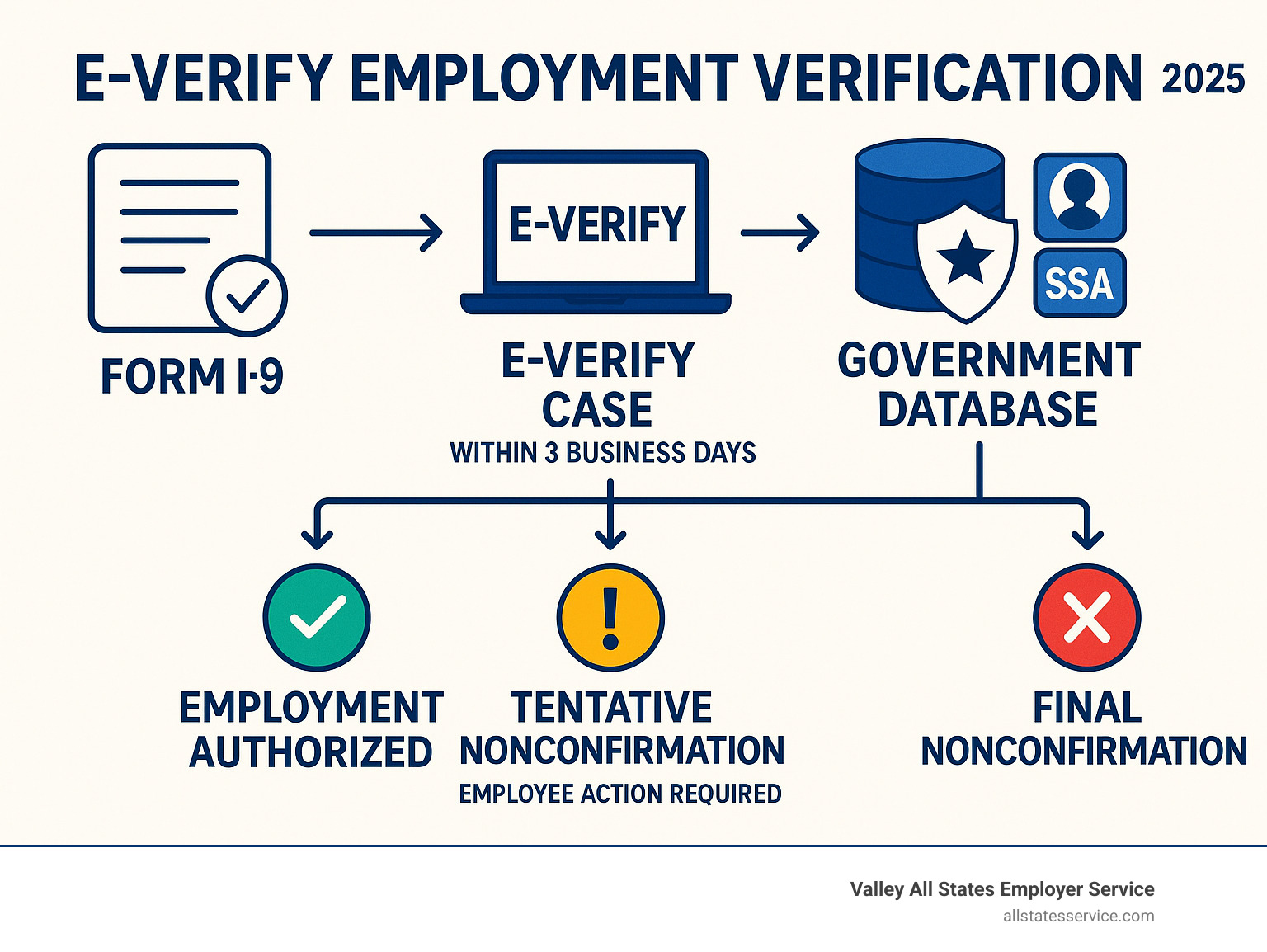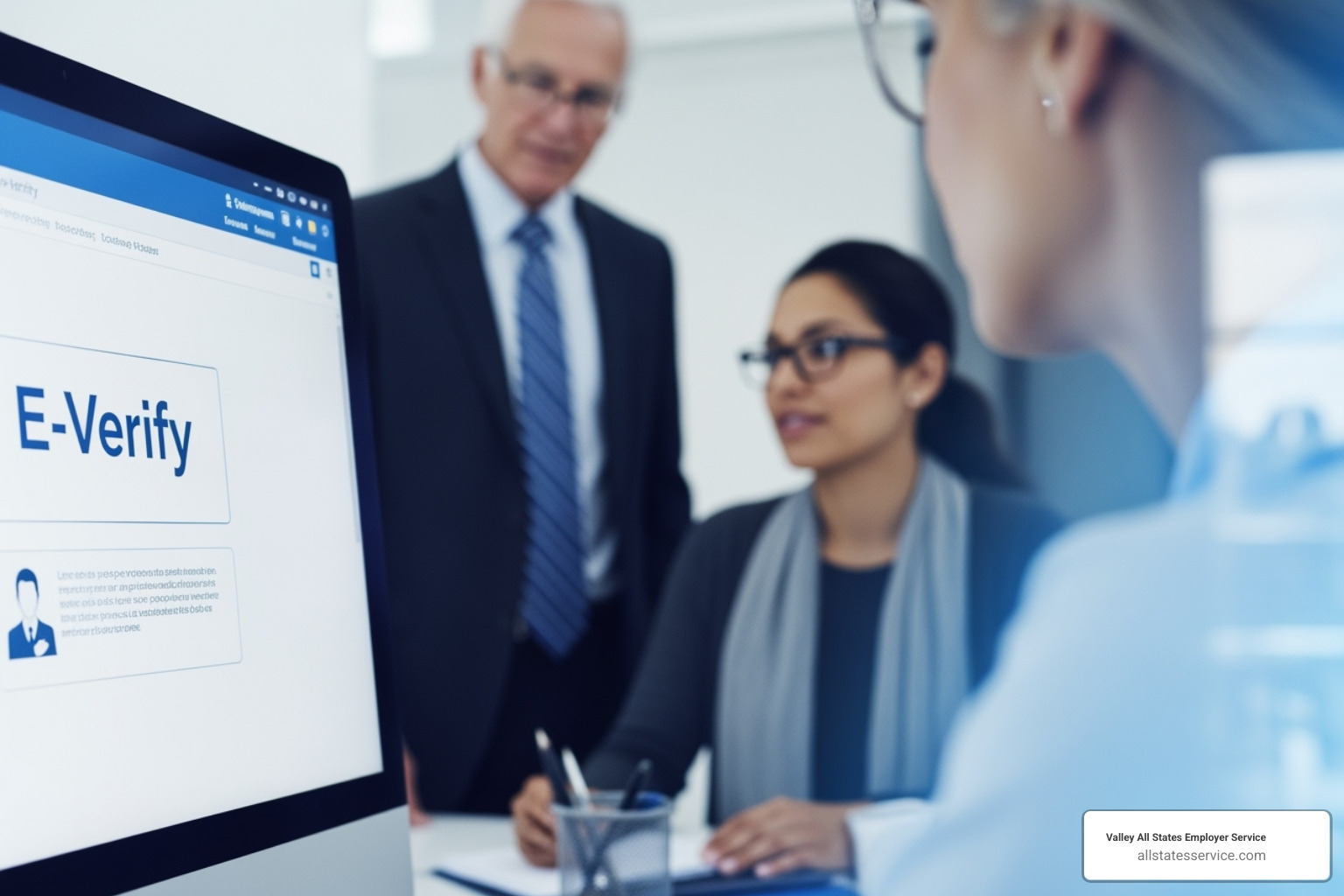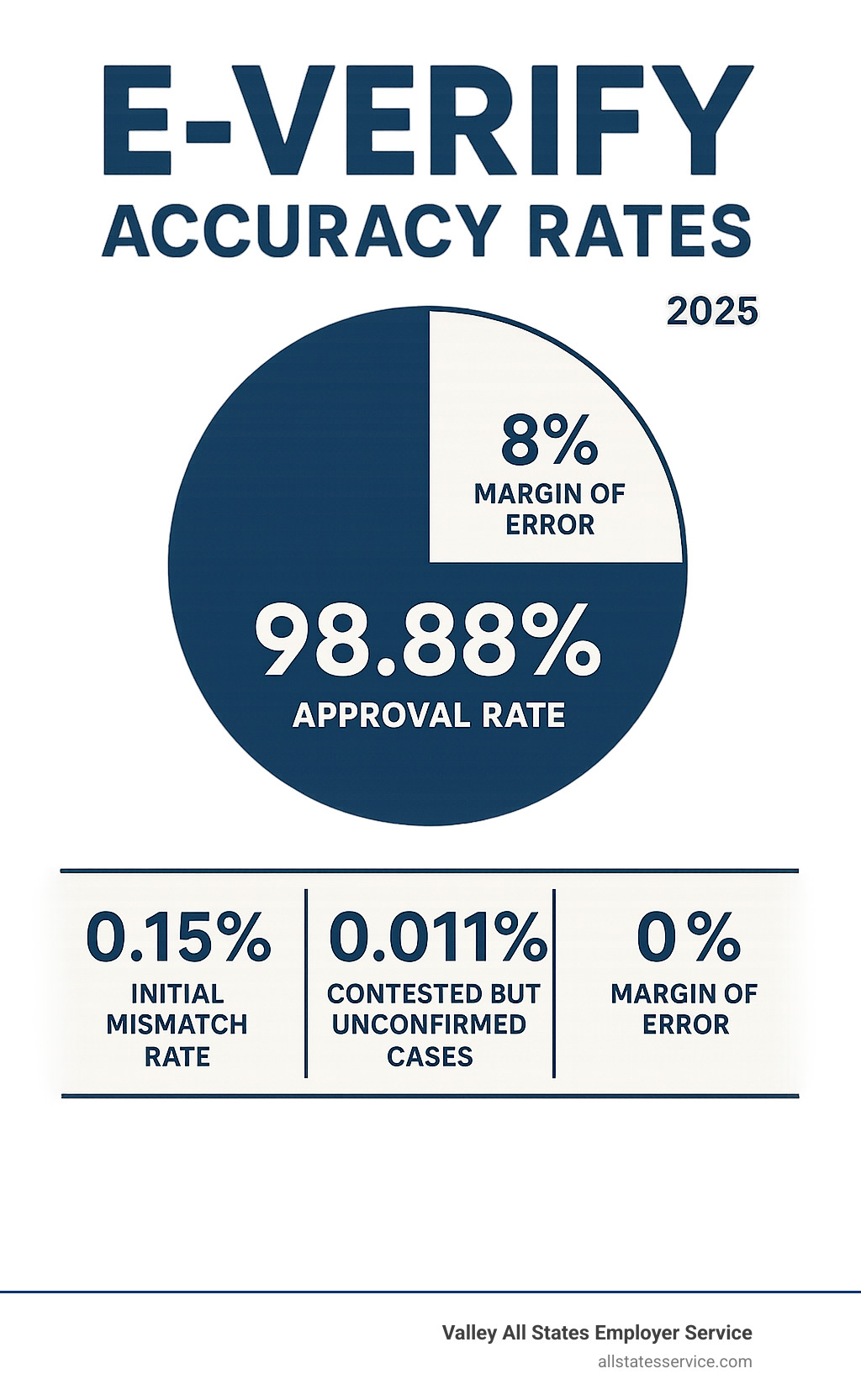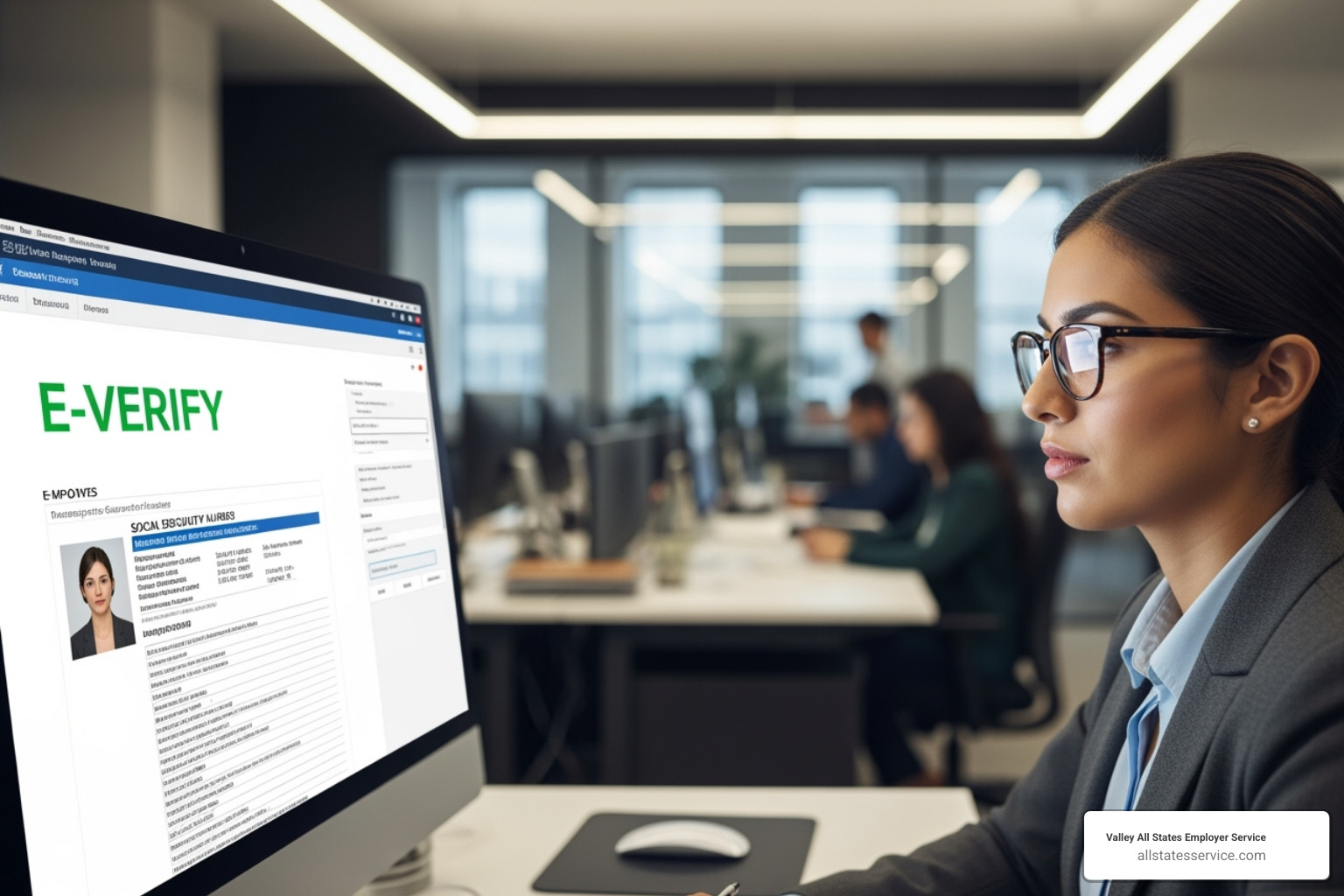Why E-Verify Employment Verification Matters for Your Business
E-Verify employment verification is a web-based system that allows employers to confirm their employees’ eligibility to work in the United States by comparing Form I-9 information against government records from the Department of Homeland Security and Social Security Administration.
Quick E-Verify Facts:
- Free government program operated by DHS and SSA
- Mandatory for federal contractors and 22 states
- Must be used within 3 business days of employee start date
- 98.88% approval rate with only 0.15% initial mismatch rate
- Supplements but doesn’t replace Form I-9 requirements
Every year, more than 700,000 employers use E-Verify to verify their workforce. But here’s what many HR managers don’t realize: E-Verify isn’t just another compliance checkbox. It’s become a critical tool for protecting your business from costly penalties while ensuring you maintain a legal workforce.
The challenge? Navigating the complex web of federal and state requirements can feel overwhelming. Some states require all employers to use E-Verify, while others make it voluntary. Federal contractors face different rules entirely. And with penalties ranging from fines to loss of business licenses, getting it wrong isn’t an option.
That’s where understanding the E-Verify process becomes essential. Whether you’re hiring your first employee or managing hundreds of new hires, knowing when and how to use this system can save you time, money, and serious compliance headaches.

Easy E-Verify employment verification glossary:
What is E-Verify and How Does It Relate to Form I-9?
Picture this: you’ve just hired a fantastic new employee, and you’re ready to get them started. You’ve completed their Form I-9, checked their documents, and filed everything away. But what if there was a way to double-check that everything is legitimate using government databases? That’s exactly where E-Verify employment verification comes in.
E-Verify is essentially the digital detective that works alongside your traditional Form I-9 process. While Form I-9 has been the cornerstone of employment eligibility verification since 1986, E-Verify takes your verification efforts to the next level by electronically confirming employee information against official government records.
This free, web-based system is a joint effort between the Department of Homeland Security (DHS) and the Social Security Administration (SSA). It’s available nationwide, covering all 50 states, the District of Columbia, Puerto Rico, Guam, the U.S. Virgin Islands, and the Commonwealth of the Northern Mariana Islands.
Here’s where it gets interesting: Form I-9 is mandatory for every single employer in the United States, regardless of company size. E-Verify, on the other hand, is generally voluntary unless you’re a federal contractor or operating in one of the 22 states that require it. But here’s the catch: when you do use E-Verify, you still must complete Form I-9 for each employee. Think of them as a team rather than competitors.
| Form I-9 | E-Verify |
|---|---|
| Required for ALL employers | Voluntary (unless mandated) |
| Paper or electronic form | Web-based system only |
| Visual document inspection | Electronic database verification |
| Completed for every employee | Used after I-9 completion |
| No time limit for completion | Must submit within 3 business days |
Need help navigating the Form I-9 requirements? Our I-9 Verification Assistance services can guide you through the process.
The Core Purpose of E-Verify
E-Verify isn’t just another government system created to make your life more complicated. It actually serves four important purposes that benefit everyone involved.
Confirming employment eligibility is the primary goal. The system cross-references your employee’s information with millions of government records to verify their work authorization. It’s like having a direct line to the government’s employment databases, giving you confidence that you’re hiring authorized workers.
Strengthening the I-9 process happens because E-Verify adds an electronic verification layer to your visual document inspection. While Form I-9 relies on your ability to spot fraudulent documents, E-Verify provides backup verification through official databases.
Maintaining a legal workforce becomes much easier when you use E-Verify. By participating in the system, you’re demonstrating your commitment to following federal employment laws and hiring only authorized workers. This proactive approach can be valuable if you ever face an audit.
Reducing document fraud is perhaps one of E-Verify’s most significant benefits. The system’s database verification makes it much harder for unauthorized workers to use fraudulent documents to gain employment, protecting both employers and legitimate workers.
For comprehensive details about the system’s capabilities and requirements, visit the official E-Verify Program Information website.
Understanding the Link to Form I-9
Form I-9 and E-Verify work together like a well-choreographed dance. Understanding their relationship is crucial for smooth implementation.
Form I-9 serves as the foundation for everything that follows. Every employee must complete Section 1 of Form I-9 on their first day of work. This includes providing their Social Security number, which becomes essential if you’re participating in E-Verify.
E-Verify uses your I-9 data as its starting point. After you complete Section 2 of the I-9 by verifying the employee’s documents, you enter this same information into the E-Verify system. The system then matches this data against DHS and SSA records to confirm everything checks out.
Additional document requirements come into play when you participate in E-Verify. If an employee presents a List B document (identity only) combined with a List C document (work authorization), the List B document must include a photograph. This requirement helps strengthen the verification process.
E-Verify is not a replacement for Form I-9, and this is where some employers get confused. You must still complete the I-9 for every employee, maintain proper records, and follow all I-9 requirements. E-Verify simply adds an extra layer of verification to your existing process.
Ready to ensure your I-9 process is audit-ready? Consider our I-9 Self Audit services to identify and address any potential issues before they become problems.
A Step-by-Step Guide to the E-Verify Employment Verification Process

Your new hire is on the clock, and so are you. E-Verify employment verification must be submitted within three business days of the start date. Miss that window and the penalties get real.
Need help lining up all these moving parts? Our Employee Onboarding Compliance team keeps the timeline tight.
Step 1: Day-One Form I-9
- Employee completes Section 1 on the first workday, including a Social Security number.
- You review original documents from the Lists of Acceptable Documents. If the employee shows a List B plus List C combo, the List B item must have a photo when you use E-Verify.
- Finish Section 2 within three days by recording the documents you saw.
Step 2: Open the E-Verify Case
- Log in, start a case, and copy details exactly as they appear on the I-9. Typos equal headaches.
- Submit the case no later than the third business day. Note the E-Verify case number on the I-9 or attach the printout. Auditors will look for it.
Step 3: Read the Result and Act Fast
- Employment Authorized – file the paperwork and move on.
- Tentative Nonconfirmation (TNC) – give the employee the referral notice right away. They get eight federal workdays to contact DHS or SSA. They keep working while the case is pending.
- Final Nonconfirmation (FNC) – after an unresolved TNC, you may terminate, but follow anti-discrimination rules to the letter.
For detailed mismatch tips, see the official resolving a mismatch guide.
Most cases clear in seconds, but knowing these steps keeps the rare hiccup from turning into a crisis.
Is E-Verify Mandatory? Federal and State Requirements Explained

Do you have to use E-Verify employment verification? That depends on your contracts, your industry, and especially your zip code.
Get lost in the rules and fines, lost licenses, and blocked contracts can follow. Our Employer HR Compliance experts keep clients on the safe side of every rule.
Federal Triggers
- Federal contractors with the FAR E-Verify clause must run every new hire company-wide plus existing staff on the covered project.
- Federal agencies have used E-Verify since 2007.
- STEM OPT hires require the employer to participate so the student can extend work authorization.
State-Level Mandates (Snapshot)
Twenty-two states now have some form of requirement, but the scope varies:
- All employers: Alabama, Arizona, Mississippi, South Carolina, and most recently Florida for firms with 25 or more workers.
- Public employers and contractors: Georgia, Texas, Utah.
- State agencies only: Colorado, Idaho, Minnesota, Nebraska.
Penalties range from several-thousand-dollar fines to temporary loss of business licenses. Some states also bar non-compliant firms from public contracts.
Because legislatures change rules often, check the latest state-by-state overview or lean on compliance pros who track updates full-time.
The Pros and Cons: Weighing the Benefits and Criticisms of E-Verify

E-Verify is powerful, but not perfect. Knowing both sides helps you decide whether to adopt it voluntarily and, if required, how to manage it smoothly. More best-practice tips live in our E-Verify Best Practices hub.
Why Employers Like It
- Fast answers: Most results arrive in seconds.
- Peace of mind: Database checks back up your I-9 review.
- Good-faith shield: Using the program shows auditors you take compliance seriously.
- Employee tools: myE-Verify lets workers lock their SSN and track cases.
The Flip Side
- Mismatch stress: Roughly 0.15 percent of cases start with a TNC. Each one means extra paperwork and potential delays.
- Data errors: Name changes or unlinked naturalization records trigger many TNCs.
- Added workload: Small teams may feel the strain of learning the system and tracking deadlines.
- Limited catch rate: Studies show a share of unauthorized workers still slip through, so the program is not a silver bullet.
Bottom line, the benefits usually outweigh the hassles when processes and training are solid.
Beyond the Basics: Exploring E-Verify+ and myE-Verify Tools

The world of E-Verify employment verification isn’t standing still. Just like your smartphone gets regular updates to work better and faster, E-Verify has evolved beyond its basic verification function. Two exciting developments are changing how both employers and employees experience the verification process.
Think of these new tools as the difference between using a flip phone and a smartphone. They both make calls, but one makes your life a whole lot easier. That’s exactly what myE-Verify and E-Verify+ are doing for employment verification.
For comprehensive support with all these evolving E-Verify tools and services, visit our E-Verify Services page.
myE-Verify: A Tool for Employees
Here’s something that might surprise you: employees now have their own E-Verify dashboard. myE-Verify puts workers in the driver’s seat of their employment verification experience, and it’s completely free.
The Self-Check Feature was historically one of myE-Verify’s most popular tools, allowing employees to verify their own eligibility before starting a new job. While temporarily unavailable, this feature helped workers identify and resolve issues proactively.
SSN Lock is like putting a security system on your Social Security number. Employees can lock their SSN to prevent unauthorized use in E-Verify. This means only legitimate employers they’ve authorized can verify their employment eligibility. It’s a simple but powerful protection against identity theft.
Case Tracker gives employees complete visibility into their E-Verify history. They can see when cases were created, which employers submitted them, and what the outcomes were. No more wondering what happened with that verification from six months ago.
Correcting Records becomes much easier when employees can spot problems themselves. If someone finds errors in their records, myE-Verify provides clear guidance on how to fix them with the right government agencies.
The important thing to remember? myE-Verify can’t change someone’s citizenship or immigration status. It’s purely a verification and tracking tool, not a way to modify official records.
E-Verify+: The Next Generation of E-Verify Employment Verification
If regular E-Verify is like driving a reliable sedan, E-Verify+ is like upgrading to a car with all the latest tech features. It’s still the same basic function, but everything works smoother and smarter.
Innovation and Efficiency drive every improvement in E-Verify+. The system’s goal is summed up in their tagline: “click, confirm and carry on.” They’re not kidding around about making verification as quick and simple as possible.
Reducing Data Entry is one of the biggest wins. E-Verify+ streamlines the entire process by integrating the I-9 and E-Verify steps more seamlessly. Less typing means fewer errors and faster processing.
Improved Security comes through integration with Login.gov. Employers now need secure government accounts for access, which adds an extra layer of protection for sensitive employee data.
Better Reporting Tools help employers stay on top of their compliance. The system now includes Status Change reports to identify cases affected by parole terminations, EAD revocation tracking, and comprehensive compliance reporting that makes audits much less stressful.
Streamlined Workflows mean the system integrates better with existing HR processes. Instead of E-Verify feeling like a separate task, it becomes part of your natural onboarding flow.
The future of employment verification is clearly heading toward making the process more transparent, efficient, and user-friendly while maintaining the security and accuracy that keeps everyone protected.
Frequently Asked Questions about E-Verify Employment Verification
Can I use E-Verify to pre-screen job applicants?
Absolutely not. This is one of the most common misconceptions about E-Verify employment verification, and it’s a mistake that can land you in serious legal trouble. The system can only be used after someone becomes your employee, not before.
Here’s the correct timeline: First, you make a job offer. Second, the candidate accepts that offer. Third, they complete Form I-9 on their first day of work. Only then can you create their E-Verify case, and you have just three business days to do it.
Using E-Verify to screen job applicants is considered discriminatory because it suggests you’re making hiring decisions based on perceived immigration status or national origin. The penalties for this type of misuse can include fines and legal action from the Department of Justice.
Think of it this way: E-Verify is designed to verify employees, not evaluate candidates. Keep that distinction clear, and you’ll avoid a costly compliance mistake.
What happens if I don’t use E-Verify when it’s required by my state?
The short answer? It won’t be pretty. States that require E-Verify take compliance seriously, and they have the enforcement tools to back up their requirements.
Penalties can hit you in multiple ways. You might face monetary fines that range from hundreds to thousands of dollars per violation. Some states can suspend your business licenses or professional certifications, effectively shutting down your operations until you comply.
If you work with government contracts, you could face contract debarment, meaning you’re prohibited from bidding on or receiving public contracts. Some states can even suspend the operating permits you need to keep your doors open.
Real-world enforcement is happening. Arizona has suspended business licenses for non-compliance. South Carolina conducts thousands of business audits every year to check E-Verify usage. Florida’s newer requirements come with significant penalties that are already being enforced.
The bottom line? If your state requires E-Verify, treat it like any other critical business requirement. The cost of compliance is always less than the cost of penalties.
How does E-Verify handle employees with temporary work authorization?
This is where E-Verify employment verification gets a bit tricky, and it’s an area where many employers make mistakes. The system handles temporary work authorization during initial verification but has specific rules for what happens when that authorization expires.
During the initial verification process, E-Verify works just like it does for any other employee. If someone has temporary work authorization like an H-1B visa or Employment Authorization Document (EAD), the system will confirm they’re currently authorized to work.
But here’s the important part: when that temporary authorization expires, you should not use E-Verify for reverification. This surprises many employers, but it’s a crucial rule to follow.
Instead of creating a new E-Verify case, you handle reverification the traditional way. Complete Section 3 of Form I-9, examine the employee’s new documents that show continued work authorization, and update your records accordingly.
There’s one exception to this rule. If the employee presents a completely new document that would normally require E-Verify verification (like a brand new EAD), you might need to create a new case. But this situation is less common and requires careful handling.
Getting reverification wrong can lead to discrimination claims or compliance violations. When in doubt, consult with compliance experts who understand these nuanced requirements.
Simplify Your Hiring and Ensure Compliance
Managing E-Verify employment verification should not derail your day. Yet missed deadlines, data entry errors, or unresolved TNCs can shut down hiring fast and invite painful fines.
Valley All States Employer Service handles E-Verify from start to finish, letting you focus on growing the business. Our team stays on top of every rule change and processes each case with expert, impartial accuracy.
Clients have found peace of mind, smoother onboarding, and fewer administrative headaches after handing E-Verify to us.
Ready to streamline compliance? Explore our solutions now at allstatesservice.com.